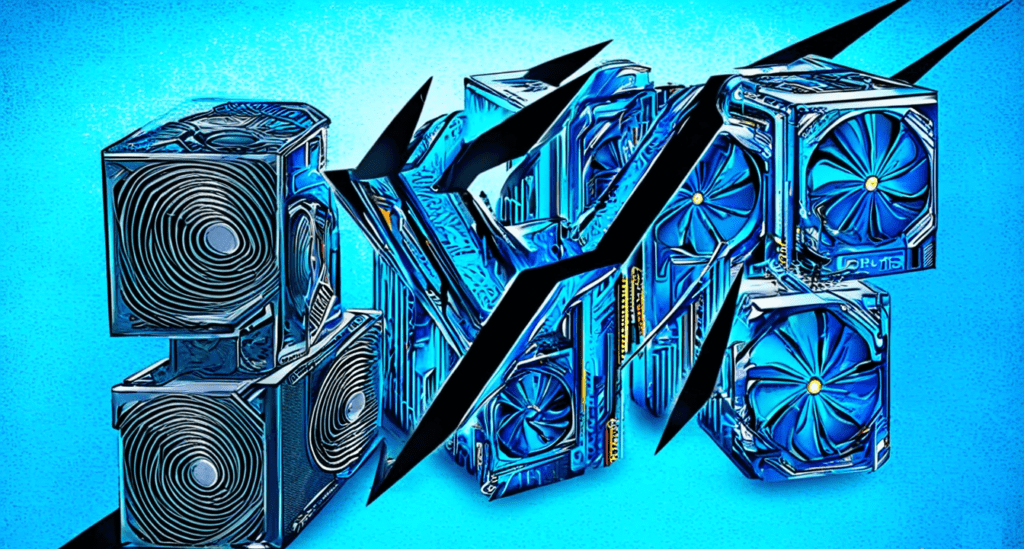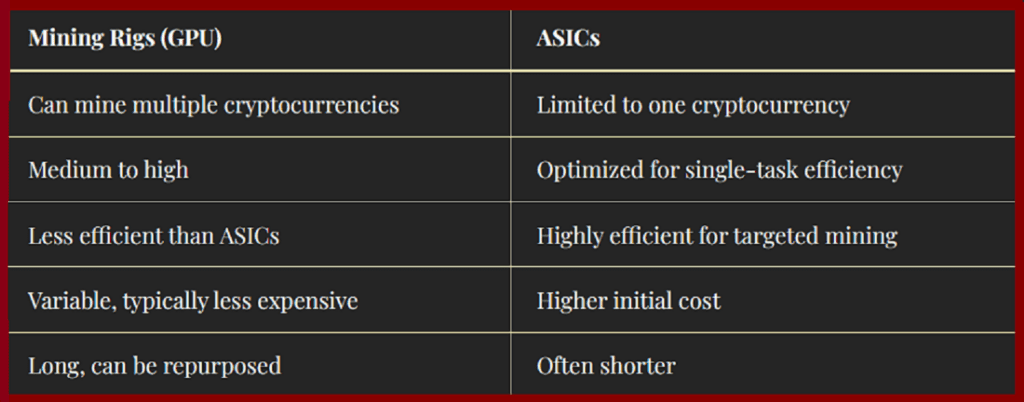
Here’s an English version of the article, structured for SEO with H2, H3 headings, bullet points, and a comparison table. This should provide a comprehensive 1,200-word introduction to cryptocurrency mining, explaining the basics, equipment types, and terms like rigs and ASICs.
What is Cryptocurrency Mining? Understanding Mining Rigs and ASICs
Cryptocurrency mining is essential for the operation of decentralized networks like Bitcoin and Ethereum. But what does it really mean to mine a cryptocurrency? This guide explains the basics of mining, the different types of equipment available, and how mining rigs and ASICs work.
Introduction to Cryptocurrency Mining
Mining, or “cryptocurrency mining,” involves using computing power to solve complex mathematical equations. This process validates and secures transactions on a blockchain network. Miners are rewarded in cryptocurrency for their efforts.
Why is Mining Necessary?
- Transaction Validation: Miners verify transactions to prevent double-spending and fraud.
- Blockchain Security: Blockchains use a consensus mechanism called Proof of Work (PoW) to secure the network, and miners are essential to this process.
- Rewards: Miners receive transaction fees and new cryptocurrency units as compensation for their work.
Types of Mining Equipment
There are two main types of mining equipment for cryptocurrencies: GPU-based mining rigs and ASICs (Application-Specific Integrated Circuits). Each has unique characteristics and advantages.
What is a Mining Rig?
A mining rig is a platform that combines multiple graphics cards (GPUs) to increase computing power. This type of equipment is versatile and can be used to mine several cryptocurrencies, especially those compatible with GPU mining, such as Ethereum.
Advantages of Mining Rigs
- Flexibility: GPU rigs allow mining of several different cryptocurrencies.
- Scalability: You can add or remove GPUs to adjust the rig’s power.
- Availability: GPUs are widely available on the market and generally more affordable than ASICs.
Disadvantages of Mining Rigs
- High Energy Consumption: Mining rigs consume a lot of electricity.
- Variable Profitability: Profitability depends on electricity costs and the cryptocurrency being mined.

What is an ASIC?
ASICs are circuits specifically designed to mine a single cryptocurrency. Unlike mining rigs, an ASIC is programmed for only one cryptocurrency (for instance, a Bitcoin ASIC can only mine Bitcoin).
Advantages of ASICs
- Efficiency: ASICs are designed for a single task, making them much more efficient than GPUs.
- Profitability: With higher computing power, ASICs can generate income more quickly.
Disadvantages of ASICs
- Single-purpose: Unlike GPU rigs, ASICs can only mine one specific cryptocurrency.
- High Cost: ASICs are generally more expensive than GPU rigs.
- Rapid Obsolescence: ASICs can quickly become obsolete if mining difficulty rises or if a new, more powerful version is released.

Comparison Between Mining Rigs and ASICs
To better understand the differences between these two types of mining equipment, here’s a comparison table:

Some Asics miners here on amazon or more informations about Asics miners here
How Does Mining Work with Rigs and ASICs?
Steps to Mine with a GPU Rig
- Set Up the Rig: Assemble a rig with multiple GPUs and configure them to work together.
- Install Mining Software: Use specific mining software like CGMiner or NiceHash for compatible cryptocurrencies.
- Choose a Cryptocurrency: Select a cryptocurrency suitable for GPUs, such as Ethereum.
- Monitor Performance: Regularly check performance and adjust settings to optimize efficiency.
Steps to Mine with an ASIC
- Purchase an ASIC: Select an ASIC compatible with the cryptocurrency you want to mine (e.g., a Bitcoin ASIC).
- Connect to Power Source: Plug the ASIC into a compatible power source.
- Connect to the Mining Network: Link the ASIC to a mining pool or network to synchronize calculations.
- Track Earnings: Monitor rewards based on the ASIC’s power and mining difficulty.
Solo cryptocurrency Mining vs. Pool Mining: Which Strategy is Better?
Choosing between solo mining and pool mining can significantly impact profitability.
Solo Mining
- Overview: Solo mining means mining blocks independently.
- Advantages: Higher rewards if a block is successfully mined.
- Disadvantages: Low likelihood of mining a block alone, especially for high-difficulty cryptocurrencies.
Pool Mining
- Overview: In a pool, multiple miners combine their computing power.
- Advantages: More consistent rewards, though shared among pool members.
- Disadvantages: Pool fees reduce overall earnings slightly.
Frequently Asked Questions on Cryptocurrency Mining
Is Mining Still Profitable?
Mining profitability depends on factors such as electricity cost, equipment, and the market price of the cryptocurrency. It’s wise to calculate potential profitability before investing in mining equipment.
Is cryptocurrency Mining Legal?
In most countries, mining is legal. However, some regions, such as China, have banned the activity, and regulations may vary by location. Checking local regulations is essential before starting.
Conclusion
Cryptocurrency mining remains a vital activity for blockchain technology, with various equipment options and strategies available. Mining rigs and ASICs each offer unique benefits, allowing miners to choose the option that best suits their budget, goals, and cryptocurrency preferences. By considering these elements, new miners can confidently begin and optimize their mining setup for profitability.
In summary, whether you choose a mining rig or an ASIC, understanding the specific features of each type of equipment is essential before starting your mining journey.


